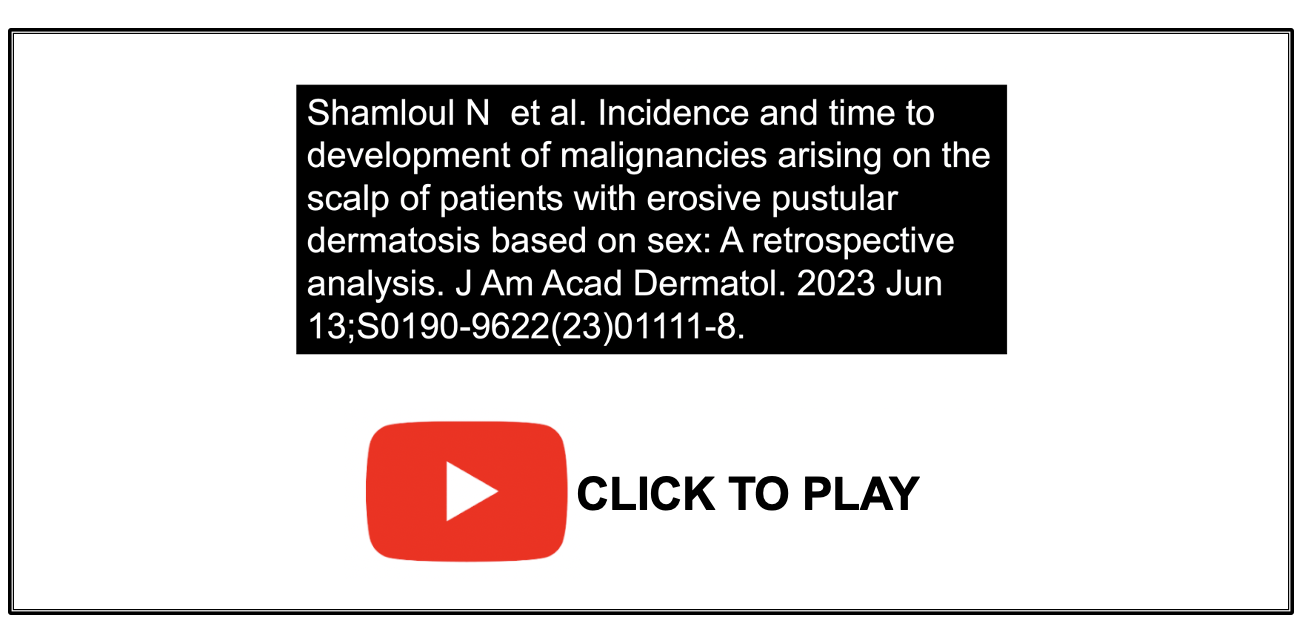Erosive Pustular Dermatosis of the Scalp: New Study Suggests 50% Have a History of Skin Cancer Before Diagnosis and 50% Develop Skin Cancer After Diagnosis
Skin Cancers May be Common in Patients with Erosive Pustular Dermatosis of the Slcap
Erosive pustular dermatosis is an inflammatory condition that often affects the scalp of older individuals. It is classified as a type of mixed scarring alopecia as it has the potential to cause scarring hair loss. Many individuals with EPDS have history of a variety of triggers that are believed to be relevant to the condition including a history of UV radiation, medication use such as topical imiquimod and destructive treatments like liquid nitrogen. Treatment with topical steroids, topical calcineurin inhibitors is often very effective although recurrences can occur. Several authors through the years have noted unexpectedly aggressive squamous cell carcinoma arising in the setting of EPDS. Some of these have contributed to the death of the patient.
Last year, we reviewed a study of 6 patients with EPDS who developed non-melanoma skin cancer. A link to this study is shown below.
Shamloul et al 2023
Authors of a new study set out to evaluate the incidence and time to development of malignancies arising on the scalp of patients with EPDS. They performed a retrospective analysis of patients with a diagnosis of EPDS of the scalp over the time period 2000 and 2021.
The authors’ study included a total of 80 patients. There were 53 males and 27 females. Most patients were white (77 of the 80 patients). About one half of patients (37 of 80, 46.2 %) had a diagnosis of scalp malignancy before the diagnosis of EPDS.
Overall, 55% of patients (44 total patients) developed a scalp skin cancer after diagnosis of EPDS diagnosis. Most patients who went on to develop skin cancer were males (72.7%, 32 of the 44 patients) and half of the patients also had a skin cancer before the diagnosis. These cancers were squamous cell carcinoma, SCC in 77.2% of patients (34 patients), basal cell carcinoma, BCC in 15.9 % of patients (7 patients), atypical fibroxanthoma in 4.6% (2 patients) and pleomorphic dermal sarcoma in 2.3 % (1 patient). 23 patients (28.8%) had more than one malignancy.
The median time from EPDS diagnosis to malignancy diagnosis was 2.44 years for males and 3.17 years for females
The authors found that there was no statistical difference between the malignancy free time for patients who had malignancy on their scalp prior to EPDS and those who did not.
Summary
This was a very interesting study. Males seem to be at higher risk than females for developing skin cancer in the setting of EPDS. Most of the cancers are SCC although BCC and other cancers may arise.
Close surveillance is clearly needed in our patients with EPDS especially when it appears that the EPDS scalp lesions have not responded fully to treatment. 50 % of these patients are likely to develop a skin cancer and many of these patient’s cancers will arise within the first 5 years. I imagine that EPDS stands for “every patient deserves surveillance” - this reminds me that I really need to be on the lookout for skin cancer. 80 % of patients with EPDS in this study had a skin cancer at some point in their journey.
The Many 50’s of EPDS
There are a lot of number 50’s in this study. 50 % of patients had a cancer before the diagnosis of EPDS. 50 % develop a skin cancer after the diagnosis. 50 % of those who develop a cancer after diagnosis had a cancer before the diagnosis too. 50% of cancers develop within 3 years.
All in all, the authors propose that EPDS may serve as a marker of sun damage since the rate of scalp malignancy is relatively high in this population.
REFERENCE
Shamloul N et al. Incidence and time to development of malignancies arising on the scalp of patients with erosive pustular dermatosis based on sex: A retrospective analysis. J Am Acad Dermatol. 2023 Jun 13;S0190-9622(23)01111-8.
Negbenebor NA et al. Nonmelanoma skin cancer in the setting of erosive pustular dermatosis of the scalp: A case series and comment on management implications. Dermatol Ther. 2022 Jul;35(7):e15584. doi: 10.1111/dth.15584. Epub 2022 May 28.
This article was written by Dr. Jeff Donovan, a Canadian and US board certified dermatologist specializing exclusively in hair loss.


